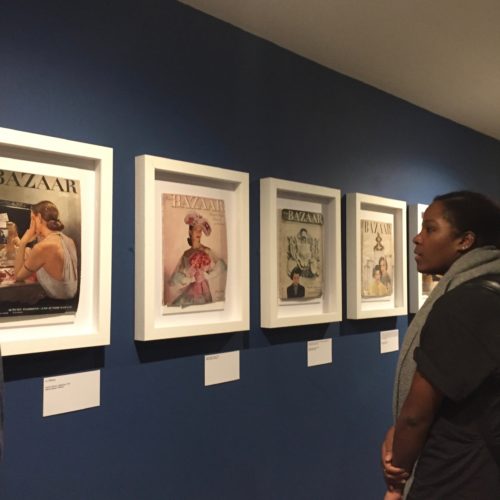In our last MA Documenting Fashion class before the end of term we discussed ‘women imagining women’ and examined the photography of Toni Frissell and Louise Dahl-Wolfe. Fortunately for us, London’s Fashion and Textile Museum currently has an exhibition of Dahl-Wolfe’s photography. A couple of my fellow MA Documenting Fashion students and I excitedly visited the exhibition together. Louise Dahl-Wolfe: A Style of Her Own appropriately began with an informative wall-text chronicling Dahl-Wolfe’s trajectory from art student to fashion photographer. A small hallway leading into the main exhibition space featured several of Dahl-Wolfe’s Harper’s Bazaar covers from the 1940s and 50s. These were not just prints of Bazaar covers, but the original magazines themselves held in simple white frames. The imperfect state of the worn magazines gave Dahl-Wolfe’s photographs a tangible materiality and reminded me that although her photographs were now presented in a museum context, most images in the exhibition were originally intended for the pages of a fashion magazine.

The main exhibition space began with examples of Dahl-Wolfe’s early photography. Experimental nudes and still lifes reflected Dahl-Wolfe’s training as an artist at the San Francisco Art Institute. I enjoyed how these early works revealed her skill for manipulating light and shadow that would define her fashion photography. These skills are also highlighted in Dahl-Wolfe’s Depression-era documentary style photographs of the residents of Gatlinburg, Tennessee. Influenced by Edward Weston and Dorthea Lange, Dahl-Wolfe began her professional career in 1930. Her photographs of the impoverished community in Gatlinburg were later included in a group photography exhibition at the Museum of Modern Art in 1937.

Halter dress by Brigance, 1954, Palm Beach
In 1936 Dahl-Wolfe became a staff photographer for Harper’s Bazaar where over the next 22 years she would produce 86 covers, 600 color pages, and thousands of black and white portraits.The exhibition featured numerous examples of Dahl-Wolfe’s fashion photography, making it impossible to choose a favorite. Among my favorites however, is the above photograph of a halter dress by Brigance taken in 1954 at Palm Beach. This image exemplifies Dahl-Wolfe expertise in light and shadow, capturing fashions in natural, outdoor settings, and rendering the subject as confident and at ease. As this image suggests, Dahl-Wolfe’s fashion photographs are shockingly modern and the influence of her dynamic images on contemporary fashion photography is astounding.

In addition to her success in fashion photography, Dahl-Wolfe continually produced portraits throughout her career. The exhibition showcased her portraits of Hollywood stars and cultural figures. Much like the subjects of her fashion images, Dahl-Wolfe’s portraits capture natural poses and the relaxed confidence of her sitters.

An unexpected yet delightful addition to the exhibition was a reproduced set of one of Dahl-Wolfe’s Harper’s Bazaar covers. Sitting on a stepped platform, a mannequin wears a bright yellow, striped 1950s play-suit and matching yellow accessories that stand out against an orange, blue, and green vinyl wall decal meant to replicate the original tiled backdrop of Dahl-Wolfe’s photograph. This scene brings the 1950s-magazine cover to life, once again adding to the materiality of the exhibition. Overall, the Fashion and Textile Museum’s exhibition beautifully presented Dahl-Wolfe’s stunning photographs and successfully highlighted the photographer’s contribution to fashion photography.
Louise Dahl-Wolfe: A Style of Her Own is on at Fashion and Textile Museum until 21 January, 2018.
Abby Fogle
All photos author’s own


